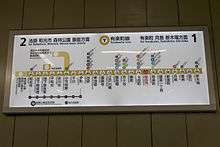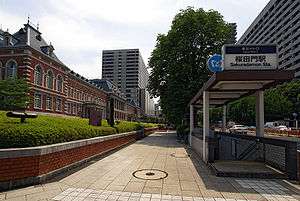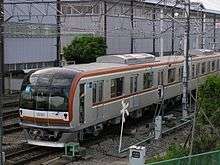Tokyo Metro Yūrakuchō Line
| Tokyo Metro Yurakucho Line | |||
|---|---|---|---|
|
| |||
|
| |||
| Overview | |||
| Native name | 東京地下鉄有楽町線 | ||
| Type | Rapid transit | ||
| Locale | Tokyo | ||
| Termini |
Wakōshi Shin-Kiba | ||
| Stations | 24 | ||
| Daily ridership | 927,104 (2010)[1] | ||
| Operation | |||
| Opened | October 30, 1974 | ||
| Owner |
| ||
| Depot(s) | Wakō, Shin-Kiba | ||
| Rolling stock | 7000 series, 10000 series, Seibu 6000 and 6050 series, Tobu 50070 series | ||
| Technical | |||
| Line length | 28.3 km (17.6 mi) | ||
| Track gauge | 1,067 mm (3 ft 6 in) | ||
| Electrification | 1,500 V DC overhead catenary | ||
| Operating speed | 80 km/h (50 mph) | ||
| |||
The Tokyo Metro Yurakucho Line (東京地下鉄有楽町線 Tōkyō Chikatetsu Yūrakuchō-sen) is a subway line in Japan owned and operated by the Tokyo subway operator Tokyo Metro. The line connects Wakōshi Station in Wakō, Saitama and Shin-Kiba Station in Kōtō, Tokyo. On maps, diagrams and signboards, the line is shown using the color "gold" ( ), and its stations are given numbers using the letter "Y".
The proper name as given in an annual report of the Ministry of Land, Infrastructure and Transport is Line No. 8 Yūrakuchō Line (8号線有楽町線 Hachi-gō-sen Yūrakuchō-sen).[2] According to the Tokyo urban transportation plan, however, it is more complicated. The line number assigned to the section south from Kotake-Mukaihara to Shin-Kiba is Line 8, but that of north of Kotake-Mukaihara to Wakōshi is Line 13, which indicates the section is a portion of Fukutoshin Line which shares the same number.
Services
The Yurakucho Line has inter-running counterparts on its northern side, both of which are "major" Japanese private railway companies in Greater Tokyo. One is the Tōbu Railway at Wakōshi, north to Shinrinkōen. The other is the Seibu Railway at Kotake-Mukaihara with its bypass line Seibu Yūrakuchō Line connecting to its main Ikebukuro Line, through trains north to Kotesashi or Hannō.
According to the Tokyo Metropolitan Bureau of Transportation, as of June 2009 the Yurakucho Line is the fifth most crowded subway line in Tokyo, at its peak running at 173% capacity between Higashi-Ikebukuro and Gokokuji stations.[3]
Semi-express (準急) services ran on the Yurakucho Line between June 14, 2008 and March 6, 2010, operating twice hourly between Wakōshi and Shin-Kiba. Between Wakōshi and Ikebukuro, semi-express trains stopped only at Kotake-Mukaihara; between Ikebukuro and Shin-Kiba, trains stopped at all stations. The semi-express trains ran between rush hours during weekdays and more frequently on weekends and holidays. These services were abolished and replaced with local services on March 6, 2010.[4]
Station list
| Station Number |
Station | Japanese | Distance (km) | Limited Express |
Transfers | Location | ||
|---|---|---|---|---|---|---|---|---|
| Between stations |
From Y-01 | |||||||
| Y-01 | Wakōshi | 和光市 | - | 0.0 | [* 1] | Tōbu Tōjō Line (some through services) |
Wakō | Saitama |
| Y-02 | Chikatetsu-Narimasu | 地下鉄成増 | 2.2 | 2.2 | Tōbu Tōjō Line (Narimasu) |
Itabashi | Tokyo | |
| Y-03 | Chikatetsu-Akatsuka | 地下鉄赤塚 | 1.4 | 3.6 | Tōbu Tōjō Line (Shimo-Akatsuka) |
Nerima | ||
| Y-04 | Heiwadai | 平和台 | 1.8 | 5.4 | ||||
| Y-05 | Hikawadai | 氷川台 | 1.4 | 6.8 | ||||
| Y-06 | Kotake-Mukaihara | 小竹向原 | 1.5 | 8.3 | Seibu Yūrakuchō Line (through trains from Ikebukuro) | |||
| Y-07 | Senkawa | 千川 | 1.0 | 9.3 | Toshima | |||
| Y-08 | Kanamechō | 要町 | 1.0 | 10.3 | ||||
| Y-09 | Ikebukuro | 池袋 | 1.2 | 11.5 | Yamanote Line, Saikyō Line, Shōnan Shinjuku Line Tōbu Tōjō Line Seibu Ikebukuro Line | |||
| Y-10 | Higashi-Ikebukuro | 東池袋 | 0.9 | 12.4 | Toden Arakawa Line (Higashi-Ikebukuro-yon-chōme) | |||
| Y-11 | Gokokuji | 護国寺 | 1.1 | 13.5 | Bunkyō | |||
| Y-12 | Edogawabashi | 江戸川橋 | 1.3 | 14.8 | ||||
| Y-13 | Iidabashi | 飯田橋 | 1.6 | 16.4 | Chūō-Sōbu Line |
Shinjuku | ||
| Y-14 | Ichigaya | 市ヶ谷 | 1.1 | 17.5 | Chūō-Sōbu Line |
Chiyoda | ||
| Y-15 | Kōjimachi | 麹町 | 0.9 | 18.4 | ||||
| Y-16 | Nagatachō | 永田町 | 0.9 | 19.3 | ||||
| Y-17 | Sakuradamon | 桜田門 | 0.9 | 20.2 | | | |||
| Y-18 | Yūrakuchō | 有楽町 | 1.0 | 21.2 | | | Yamanote Line, Keihin-Tōhoku Line | ||
| Y-19 | Ginza-itchōme | 銀座一丁目 | 0.5 | 21.7 | | | Chūō | ||
| Y-20 | Shintomichō | 新富町 | 0.7 | 22.4 | | | |||
| Y-21 | Tsukishima | 月島 | 1.3 | 23.7 | | | |||
| Y-22 | Toyosu | 豊洲 | 1.4 | 25.1 | ● | Yurikamome | Kōtō | |
| Y-23 | Tatsumi | 辰巳 | 1.7 | 26.8 | | | |||
| Y-24 | Shin-Kiba | 新木場 | 1.5 | 28.3 | ● | Keiyō Line Rinkai Line | ||
- ↑ The limited express Romancecar service Bay Resort runs between Shin-Kiba and Hon-Atsugi on the Odakyū Odawara Line two to three times a month, connecting via tracks between Sakuradamon and Kasumigaseki to the Chiyoda Line.
Rolling stock
All types are operated as 10-car sets.
Tokyo Metro
- 7000 series (from 1974)
- 10000 series (from September 2006)
Other operators
- Seibu 6000 and 6050 series (Not all sets are permitted to run on Yūrakuchō Line tracks)
- Tobu 9000 series x 8
- Tobu 9050 series x 2
- Tobu 50070 series (from July 2007)
- Odakyu 60000 series MSE (Romancecar, as Limited Express Bay Resort, occasionally)
Former rolling stock
- Tokyo Metro 07 series (from 1992 until 2007)[5]
Depots

- Wakō Depot (和光検車区) (main depot)
- Shin-Kiba Depot (新木場検車区) (responsible for minor inspections; for major ones, EMUs are forwarded to the Ayase Depot (綾瀬車両基地) on the Chiyoda Line via underground connecting tracks)
- Shin-Kiba Car Renewal (新木場CR) (specializes in railcar refurbishment: also used for Chiyoda and Hanzōmon Line railcars)
History


- October 30, 1974: Ikebukuro - Ginza-itchōme opens.
- March 27, 1980: Ginza-itchōme - Shintomichō opens.
- June 24, 1983: Eidan Narimasu (present Chikatetsu Narimasu) - Ikebukuro
- October 1, 1983: Seibu Railway Seibu Yūrakuchō Line Kotake-Mukaihara - Shin-Sakuradai opened, through operation.
- August 25, 1987: Wakōshi - Eidan Narimasu. Through service to Tōbu Tōjō Line.
- June 8, 1988: Shintomichō - Shin-kiba, current line completed.
- March 18, 1993: 07 series EMUs introduced.
- December 7, 1994: Quadruple-track from Kotake-Mukaihara to Ikebukuro. New double track section was named "Yūrakuchō New Line", all trains made Ikebukuro their terminus, and did not stop at Senkawa nor Kanamechō. Through service from Shin-Kiba or Ikebukuro (on the New Line) to Nerima on Seibu Yūrakuchō Line due to completion of the line.
- March 26, 1998: Through operation to Seibu Ikebukuro Line .
- April 1, 2004: According to its privatization, the management subject changed from Teito Rapid Transit Authority (TRTA, Eidan) to Tokyo Metro.
- October 31, 2005: Women-only cars introduced.
- September 1, 2006: 10000 series introduced.
- May 3, 2008: Limited Express "Bay Resort" (operated first from/to Odakyu Line)
- June 14, 2008: Tokyo Metro Fukutoshin Line began service. Yurakuchō New Line annexed to a part of Fukutoshin Line, and Yurakuchō Line share double tracks with Fukutoshin Line between Wakōshi and Kotake-Mukaihara. Semi-Express service started.
- October 2008: CS-ATC enabled on the Yurakuchō Line.
- March 6, 2010: Semi-express services abolished.
From 10 September 2012, 10-car 5050-4000 series sets entered revenue service on the Yurakucho Line, with inter-running through to the Tobu Tojo Line.[6]
Future developments
A branch line has been planned since the early 1980s from Toyosu Station, heading north via Kameari Station (on the Jōban Line) to Noda in northwest Chiba Prefecture.[7]
References
- ↑ Tokyo Metro station ridership in 2010 Train Media (sourced from Tokyo Metro) Retrieved May 28, 2012.
- ↑ 株式会社電気車研究会・鉄道図書刊行会。鉄道要覧 (Tetsudō Yōran)。 (Issued every September)
- ↑ Metropolis, "Commute", June 12, 2009, p. 07. Capacity is defined as all passengers having a seat or a strap or door railing to hold on to.
- ↑ 3月6日(土)有楽町線・副都心線のダイヤ改正 (Japanese) February 3, 2010. Accessed March 6, 2010.
- ↑ Shiina, Takayuki (February 2009). 東京地下鉄07系 転籍計画の概要 [Outline of Tokyo Metro 07 series reallocation plan]. Japan Railfan Magazine (in Japanese). Vol. 49 no. 574. Japan: Koyusha Co., Ltd. pp. 80–83.
- ↑ 東急5050系4000番台が東武東上線・地下鉄有楽町線で営業運転開始 [Tokyu 5050-4000 series enters service on the Tobu Tojo Line and Tokyo Metro Yurakucho Line]. Japan Railfan Magazine Online (in Japanese). Japan: Koyusha Co., Ltd. 11 September 2012. Retrieved 11 September 2012.
- ↑ 平成22年度予算案プレス発表(仮称)江東区地下鉄8号線建設基金を創設 (Japanese)
- Shaw, Dennis and Morioka, Hisashi, "Tokyo Subways", published 1992 by Hoikusha Publishing
External links
| Wikimedia Commons has media related to Tokyo Metro Yūrakuchō Line. |

